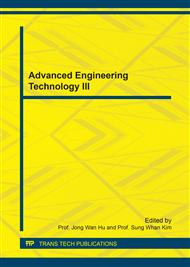[1]
B. C. Liu, J. S. Zhang, Q. Z. Du, et al. A study of size effect for compression strength of rock, J. Chin. J. Rock Soil Mech. Eng. 17(6) (1998) 611-614.
Google Scholar
[2]
M. Q. You, C. D. Su, Effect of length of fine and coarse crystal marble specimens on uniaxial compression tests, J. Chin. J. Rock Mech. Eng. 23(22) (2004) 3754-3760.
Google Scholar
[3]
S. J. Yang, H. Zeng, H. L. Wang, Experimental analysis on mechanical effescts of loading rates on limestone, J. Chin. J. Geotech. Eng. 27(7) (2005) 786-788.
Google Scholar
[4]
K. Yang, L. Yuan, L. G. Qi, et al. Establishing predictive model for rock uniaxial compressive strength of No. 11-2 coal seam roof in Huainan mining area, J. Chin. J. Rock Soil Mech. Eng. 32(10) (2013) 1991-(1998).
Google Scholar
[5]
H. S. Li, G. R. Wei, To determine rock shear strength parameters using random-fuzzy linear regression method, J. Tongji Univ. 21(3) (1993) 421-429.
Google Scholar
[6]
W. L. Xiong, H. S. Li, A random-fuzzy method for treating the experimental data of mechanical parameters of rock sample, J. Chin. J. Geotech. Eng. 14(6) (1992) 101-108.
Google Scholar
[7]
P. Horsrud, Estimating mechanical properties of shale from empirical correlations, J. SPE Drilling & Completion, 16(02) (2001) 68-73.
DOI: 10.2118/56017-pa
Google Scholar
[8]
N. Sabatakakis, G. Koukis, G. Tsiambaos, et al. Index properties and strength variation controlled by microstructure for sedimentary rocks, J. Eng. Geol. 97(1) (2008) 80-90.
DOI: 10.1016/j.enggeo.2007.12.004
Google Scholar
[9]
C. D. Chang, M. D. Zoback, A. Khaksar, Empirical relations between rock strength and physical properties in sedimentary rocks, J. Petrol. Sci. Eng. 51(3-4) (2006) 223-237.
DOI: 10.1016/j.petrol.2006.01.003
Google Scholar
[10]
Z. R. Meng, J. C. Zhang, T. Joachim, Relationship between physical and mechanical parameters and acoustic wave velocity of coal measures rocks, J. Chin. J. Geophys. 49(5) (2006) 1505-1510.
DOI: 10.1002/cjg2.959
Google Scholar
[11]
S. M. Liu, L. H. Xu, Y. Q. Li, Experimental study on rock physical and mechanical properties in Danjiangkou reservoir area, J. Huazhong Univ. Sci. Technol. (Urban Science Edition), 24(4) (2007) 54-58.
Google Scholar
[12]
E. Hoek, E. T. Brown, Underground excavations in rock, The institution of mining and metallurgy, (1980).
Google Scholar
[13]
R. P. Bewick, F. Amann, P. Kaiser, et al. Interpretation of UCS test results for engineering design, J. 13th ISRM Int. Congress of Rock Mech. (2015).
Google Scholar
[14]
E. Brown, ISRM suggested methods. Rock characterization testing and monitoring. Pergamon Press, Oxford; (1981).
Google Scholar
[15]
ASTM. Standard Test Method for Elastic Moduli of Intact Rock Core Specimens in Uniaxial Compression. Annual Book of ASTM Standards, Section 4, Construction.
DOI: 10.1520/d3148-96
Google Scholar
[16]
W. Dearman, F. Baynes, T. Irfan, Engineering grading of weathered granite, J. Eng. Geol. 12 (1978) 345-374.
DOI: 10.1016/0013-7952(78)90018-2
Google Scholar
[17]
A. Tuǧrul, The effect of weathering on pore geometry and compressive strength of selected rock types from Turkey, J. Eng. Geol. 75(3) (2004) 215-227.
DOI: 10.1016/j.enggeo.2004.05.008
Google Scholar
[18]
L. Vernik, M. Bruno, C. Bovberg, Empirical relations between compressive strength and porosity of siliciclastic rocks, J. Int. J. Rock Mech. Min. Sci. Geomech. Abstr. 30(7) (1993) 677-680.
DOI: 10.1016/0148-9062(93)90004-w
Google Scholar
[19]
V. Palchik, Y. Hatzor, Crack damage stress as a composite function of porosity and elastic matrix stiffness in dolomites and limestones, J. Eng. Geol. 63(3) (2002) 233-245.
DOI: 10.1016/s0013-7952(01)00084-9
Google Scholar
[20]
E. Arioglu, N. Tokgoz, Estimation of rock strength: rapidly and reliably by the Schmidt hammer, J. Mines, Metals Fuels, 39(9-10) (1991) 327-330.
Google Scholar
[21]
A. Best, C. McCann, J. Sothcott, The relationships between the velocities, attenuations and petrophysical properties of reservoir sedimentary rocks1, J. Geophys. Prospect. 42(2) (1994) 151-178.
DOI: 10.1111/j.1365-2478.1994.tb00204.x
Google Scholar
[22]
D. H. Johnston, M. N. Toksöz, Ultrasonic P and S wave attenuation in dry and saturated rocks under pressure, J. Geophys. Res.: Solid Earth, 85(B2) (1980) 925-936.
DOI: 10.1029/jb085ib02p00925
Google Scholar
[23]
E. Mashinskii, Variants of the strain-amplitude dependence of elastic wave velocities in rocks under pressure, J. Geophys. Eng. 1(4) (2004) 295.
DOI: 10.1088/1742-2132/1/4/008
Google Scholar


